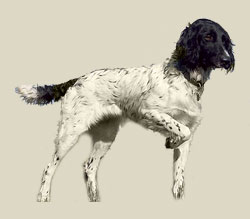
Country of Origin: Hungary
Group: Pointing Dogs
Section: Continental Pointing Dogs
Original Function: pointing, falconry, trailing
Todays Function: pointing, pointing field trials
Dimension Male: 23-32 cm
Dimension Female: 23-32 cm
Weight Male: 55-65 kg
Weight Female: 55-65 kg
Litter Size: 6-8 puppies, average 7
Life span: 10-14 years
Other Names: Large Munsterlander, Grosser Munsterlander Vorsteh
Colors: White with black patches, flecked and/or ticked. All black and Brown do occur.
Living: The Large Munsterlander is not recommended for apartment life. They are moderately active indoors an
Recognized: LMCNA, FCI, KCGB, NKC, NZKC, CKC, ANKC, APRI, ACR, DRA
Description
The Large Munsterander possesses a well-balanced conformation suggestive of easy, steady movement and drive. The breed s head is sufficiently broad and slightly rounded giving an impression of stability, even dignity. Solid black with a white snip or star is allowed. The body is white with black patches, flecked and/or ticked. An all black coat is not desirable to breeders. Brown coats do occur, but are not common. Its broad, round-tipped ears hang close to the head. They should have a scissors bite. The eyes are dark and heavy lidded. The coat is long and dense, neither curly nor coarse. It has feathers on the ears, front and hind legs, and tail. There should be no feathering on the backside of the upper feet, so that you can see the 90 degree angle. Males usually have larger heads, longer hair on the chest and more feathering than females. When the dog stands, his extended hind feet should stand in a right angle to the ground. It has firm, strong feet with ample hair between the black-nailed toes. The tail is carried horizontally and may be left intact or have a just a tiny bit of the end removed. The Large Munsterlander has an elegant gait.
Temperament
The Large Munsterlander is courageous, cheerful, intelligent and obedient. It makes a wonderful house companion dog and is very trainable. Munsterlanders are loyal and friendly dogs that are responsive to their humans. They make very good friends. If the Munsterlander is lacking in leadership and or mental and pysical exercise they can get destructive and bark when left alone in the house. They are not guard dogs. They like to retrieve and naturally like to carry things about in their mouths. The Munster does well in obedience, and is good with other animals and with children. Under exercised Munsterlanders can get too overly excited and high strung. They will be happiest when used as working dogs. Bred for training and ability to withstand the pressures involved, this dog will adapt to any terrain whether it be valleys, prairies, forest or water, and to every type of hunting. It is resistant to fatigue and to bad weather. Particularly appreciated for the sureness of its point and the precision with which it retrieves. Munsterlanders can easily learn to come and sit on command in the first six months of life. Proper human to canine communication is essential. They love water and will try to retrieve everything out of the water. They are not difficult dogs. If one has a firm hand, even a beginner can manage this breed without a problem, however they must remain firm, but calm, confident and consistent throughout the dog s life. It is a slow maturing dog, so don t "over-train" in its field work at too young an age. The breed has shown itself to be a dedicated enemy of birds of prey and they may try to attack small farm animals, however they can be trained to leave sheep and cattle alone. Although he will chase every small rodent and bird, he can t be bothered to chase cars, joggers and bikes. When he spots a bird or rabbit he will usually freeze in his motion. His head will point towards the prey and his whole body shifts slightly forward; one of the front feet will often be off the ground. The rapid motion freeze will prevent the prey from being alarmed and shows the hunter where the prey is hiding. The position can be often seen in old pictures and paintings and is typical for breeds such as pointers. Described by the German word "Vorsteh" (hund).
Excercise
As with all their hunting relatives, they require sufficient exercise, although not as much as a pointer. They need to be taken on a daily, brisk walk or jog. While out on the walk the dog must be made to heel beside or behind the person holding the lead, as in a dog s mind the leader leads the way, and that leader needs to be the human. In addition, if you engage them in active play, then he will usually be tired in 20 minutes. Two to three 20-30 minute sessions a day will make this dog happy. They love to be outside and run around free. Munsterlanders will search for rabbits under every bush they can find. This is not a dog for older people or inactive people. It will do best with people who love to be in the outdoors.
Grooming
The bitch has a shorter coat and will not need so much grooming. A brushing every 3-4 days should be enough. The dog has a longer coat and needs a good brushing every second day. This breed is a seasonally heavy shedder especially in the spring. Regular g
Health
Major concerns: none
Minor concerns: hemophilia A, CMO, CHD
Occasionally seen: none
Suggested tests: (hip)

